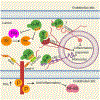Antithrombin: An anticoagulant, anti-inflammatory and antibacterial serpin
- PMID: 32112532
- PMCID: PMC7080319
- DOI: 10.1111/jth.14724
Antithrombin: An anticoagulant, anti-inflammatory and antibacterial serpin
Conflict of interest statement
Disclosure of Conflict of Interests
The authors declare no conflict of interests.
Figures

Similar articles
-
The antithrombin P1 residue is important for target proteinase specificity but not for heparin activation of the serpin. Characterization of P1 antithrombin variants with altered proteinase specificity but normal heparin activation.Biochemistry. 2001 Jun 5;40(22):6670-9. doi: 10.1021/bi002933d. Biochemistry. 2001. PMID: 11380262
-
Effects of acrolein, a natural occurring aldehyde, on the anticoagulant serpin antithrombin.FEBS Lett. 2009 Oct 6;583(19):3165-70. doi: 10.1016/j.febslet.2009.07.062. Epub 2009 Sep 1. FEBS Lett. 2009. PMID: 19729010
-
Inhibition of proteasome by bortezomib causes intracellular aggregation of hepatic serpins and increases the latent circulating form of antithrombin.Lab Invest. 2008 Mar;88(3):306-17. doi: 10.1038/labinvest.3700717. Epub 2008 Jan 14. Lab Invest. 2008. PMID: 18195690 Clinical Trial.
-
Anticoagulant and signaling functions of antithrombin.J Thromb Haemost. 2020 Dec;18(12):3142-3153. doi: 10.1111/jth.15052. Epub 2020 Sep 9. J Thromb Haemost. 2020. PMID: 32780936 Free PMC article. Review.
-
Identification of critical molecular interactions mediating heparin activation of antithrombin: implications for the design of improved heparin anticoagulants.Trends Cardiovasc Med. 2002 Jul;12(5):198-205. doi: 10.1016/s1050-1738(02)00160-3. Trends Cardiovasc Med. 2002. PMID: 12161073 Review.
Cited by
-
A 3-O-sulfated heparan sulfate dodecasaccharide (12-mer) suppresses thromboinflammation and attenuates early organ injury following trauma and hemorrhagic shock.Front Immunol. 2023 Apr 14;14:1158457. doi: 10.3389/fimmu.2023.1158457. eCollection 2023. Front Immunol. 2023. PMID: 37122735 Free PMC article.
-
Influence of albumin concentration on surface characteristics and cellular responses in the pre-incubation of multi-walled carbon nanotubes.Nanoscale Adv. 2024 Oct 10;6(22):5585-97. doi: 10.1039/d4na00743c. Online ahead of print. Nanoscale Adv. 2024. PMID: 39398624 Free PMC article.
-
Changes in the pulmonary surfactant in patients with mild to moderate COVID-19.PLoS One. 2025 Aug 7;20(8):e0325153. doi: 10.1371/journal.pone.0325153. eCollection 2025. PLoS One. 2025. PMID: 40773458 Free PMC article.
-
Antithrombin and Its Role in Host Defense and Inflammation.Int J Mol Sci. 2021 Apr 20;22(8):4283. doi: 10.3390/ijms22084283. Int J Mol Sci. 2021. PMID: 33924175 Free PMC article. Review.
-
Risk factors for mechanical ventilation and ECMO in COVID-19 patients admitted to the ICU: A multicenter retrospective observational study.PLoS One. 2022 Nov 14;17(11):e0277641. doi: 10.1371/journal.pone.0277641. eCollection 2022. PLoS One. 2022. PMID: 36374929 Free PMC article.
References
Publication types
MeSH terms
Substances
Grants and funding
LinkOut - more resources
Full Text Sources

